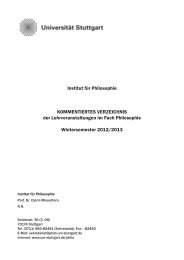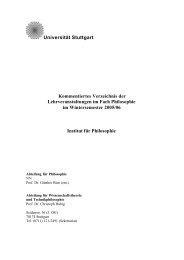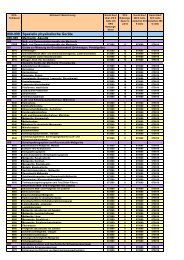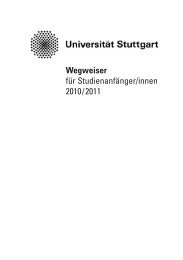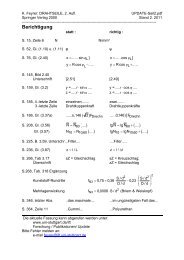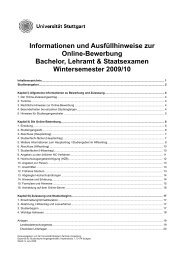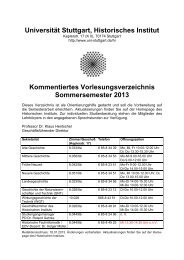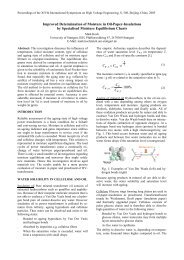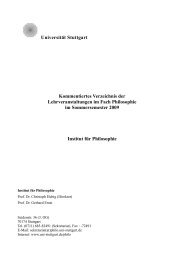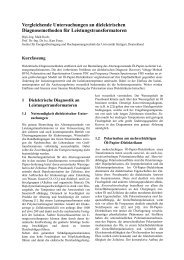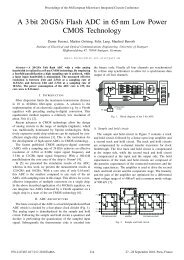Discourse Structure and the Structure of Context - Multiple Choices
Discourse Structure and the Structure of Context - Multiple Choices
Discourse Structure and the Structure of Context - Multiple Choices
Create successful ePaper yourself
Turn your PDF publications into a flip-book with our unique Google optimized e-Paper software.
22<br />
which are (presumed to be) shared by utterer <strong>and</strong> addressee. It should<br />
be clear from what I have said that this is <strong>the</strong> role for anchors in <strong>the</strong><br />
present essay. Indeed, each <strong>of</strong> <strong>the</strong> components <strong>of</strong> articulated conctexts<br />
may contain anchored discourse referents (with <strong>the</strong> exception <strong>of</strong> KGen,<br />
which presumably has no discourse referents in its main universe at<br />
all). This I assume is true in particular <strong>of</strong> KEnc. In fact, for discourse<br />
referents in KEnc I take this to be <strong>the</strong> typical case; <strong>and</strong> that in particular<br />
for those discourse referents which "represent by name", i.e. those<br />
discourse referents xN which are accompanied by a condition <strong>of</strong> <strong>the</strong><br />
form "Named(xN,N)".<br />
This means that <strong>the</strong> directly referential character <strong>and</strong> function <strong>of</strong> <strong>the</strong><br />
name N are part <strong>of</strong> <strong>the</strong> common ground that is presupposed by<br />
discourse-initial uses <strong>of</strong> N. Moreover, when N is used as part <strong>of</strong> an<br />
utterance U, <strong>the</strong> directly referential function <strong>of</strong> N is transferred from<br />
KEnc both to <strong>the</strong> representation <strong>of</strong> <strong>the</strong> content <strong>of</strong> U <strong>and</strong> to <strong>the</strong><br />
discourse context (into which <strong>the</strong> use <strong>of</strong> N introduces xN). 17<br />
What about uses <strong>of</strong> proper names that are not discourse-initial? It has<br />
been noted that such uses have an anaphoric character. (See (Geurts,<br />
17 Note that it is possible for different names N1 <strong>and</strong> N2 to be anchored to <strong>the</strong><br />
same entity d. This may happen in one <strong>of</strong> two ways. The first one, which holds no<br />
particular inerest, is that where a single discourse referent x comes with two naming<br />
conditions, "Named(x,N1)" <strong>and</strong> "Named(x,N2)", Suppose that x is anchored to <strong>the</strong><br />
individual d. The intuitive meaning <strong>of</strong> this configuration is that <strong>the</strong> discourse<br />
participants have a representation <strong>of</strong> <strong>the</strong> individual d that is known under two<br />
different names, N1 <strong>and</strong> N2. In such a case ei<strong>the</strong>r N1 or N2 could be used felicitously<br />
in a discourse reference to d. The more interesting case is that where KEnc contains<br />
two distinct discourse referents x <strong>and</strong> y with <strong>the</strong> naming conditions "Named(x,N1)"<br />
<strong>and</strong> "Named(y,N2)" <strong>and</strong> <strong>the</strong> anchors <strong>and</strong> . In effect this means that N1<br />
<strong>and</strong> N2 are two names for <strong>the</strong> same thing, but that <strong>the</strong> discourse participants may be<br />
unaware that <strong>the</strong>y have <strong>the</strong> same bearer. It is important in this connection that<br />
external anchors should not be seen as part <strong>of</strong> <strong>the</strong> explicit knowledge <strong>of</strong> those who are<br />
in possession <strong>of</strong> <strong>the</strong> representations containing <strong>the</strong> anchored discousre referents.<br />
External anchors may be implied by <strong>the</strong> knowledge <strong>of</strong> <strong>the</strong> one in possession <strong>of</strong> <strong>the</strong><br />
representation, in combination with <strong>the</strong> way in which this agent is linked up to <strong>the</strong><br />
world (directly or as part <strong>of</strong> a larger society). But it is in <strong>the</strong>ir nature that <strong>the</strong> specific<br />
information <strong>the</strong>y contribute is not capturable in purely representational terms in any<br />
case; <strong>and</strong> especially in <strong>the</strong> case <strong>of</strong> proper names <strong>the</strong> actually representable knowledge<br />
may, as we noticed above, fall very far short <strong>of</strong> this contribution, or may even be in<br />
conflict with it. Thus two discourse participants who share <strong>the</strong> information given by<br />
KEnc may have representations for entities named as N1 <strong>and</strong> N2, be committed to<br />
<strong>the</strong>se entites being in fact one <strong>and</strong> <strong>the</strong> same, but yet be unaware <strong>of</strong> this fact.



